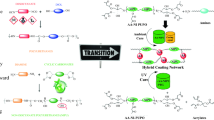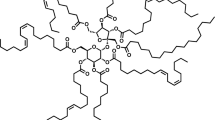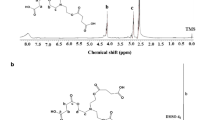Abstract
The growing concerns and impending regulations on the usage of monomeric isocyanates in the production of polyurethane resins have led to the introduction of alternative non-isocyanate polyurethane (NIPU) systems. Although two-component NIPU coatings based on the reaction of cyclic carbonates and aliphatic amines have emerged as a promising option, they are still associated with two significant drawbacks: lower crosslinking densities due to reduced functionality of the oligomers and low ambient-temperature reactivity. This study reports the utilization of a hybrid approach to address these drawbacks. Amine-functional NIPU oligomers (NI-PUPA) were synthesized by the reaction of cycloaliphatic amine functional compounds and multi-functional cyclic carbonates in an excess amine molar ratio. After mixing the NI-PUPAs with (3-glycidyloxypropyl) trimethoxysilane (GPTMS), a dual-curable coating could be achieved by ambient curing of amines and epoxies and moisture curing of alkoxy silanes. A comparative experimental design was implemented to evaluate the effect of an additional curing mechanism. The results revealed that the additional moisture curing led to faster ambient curing, faster development of properties, enhanced flexibility even at higher crosslinking densities, and better corrosion resistance. Such advancement could facilitate the future implementation of NIPUs in high-performance ambient-curing coating applications.










Similar content being viewed by others
References
Janik, H, Sienkiewicz, M, Kucinska-Lipka, J, “Polyurethanes.” In: Handbook of Thermoset Plastics, pp. 253–295. Elsevier. https://doi.org/10.1016/B978-1-4557-3107-7.00009-9 (2014).
Frick, M, Isaksson, M, Bjorkner, B, Hindsen, M, Ponten, A, Bruze, M, “Occupational Allergic Contact Dermatitis in a Company Manufacturing Boards Coated with Isocyanate Lacquer.” Contact Dermatitis, 48 255–260. https://doi.org/10.1034/j.1600-0536.2003.00107.x (2003)
Goossens, A, Detienne, T, Bruze, M, “Occupational Allergic Contact Dermatitis Caused by Isocyanates.” Contact Dermatitis, 47 304–308. https://doi.org/10.1034/j.1600-0536.2002.470509.x (2002)
Rokicki, G, Parzuchowski, PG, Mazurek, M, “Non-isocyanate Polyurethanes: Synthesis, Properties, and Applications.” Polym. Adv. Technol., 26 707–761. https://doi.org/10.1002/pat.3522 (2015)
Kathalewar, MS, Joshi, PB, Sabnis, AS, Malshe, VC, “Non-isocyanate Polyurethanes: From Chemistry to Applications.” RSC Adv., 3 4110. https://doi.org/10.1039/c2ra21938g (2013)
Neffgen, S, Keul, H, Höcker, H, “Cationic Ring-Opening Polymerization of Trimethylene Urethane: A Mechanistic Study.” Macromolecules, 30 1289–1297. https://doi.org/10.1021/ma9610774 (1997)
Li, S, Zhao, J, Zhang, Z, Zhang, J, Yang, W, “Aliphatic Thermoplastic Polyurethane-Ureas and Polyureas Synthesized Through a Non-isocyanate Route.” RSC Adv., 5 6843–6852. https://doi.org/10.1039/C4RA12195C (2015)
Kotanen, S, Laaksonen, T, Sarlin, E, “Feasibility of Polyamines and Cyclic Carbonate Terminated Prepolymers in Polyurethane/Polyhydroxyurethane Synthesis.” Mater. Today Commun., 23 100863. https://doi.org/10.1016/j.mtcomm.2019.100863 (2020)
Blattmann, H, Fleischer, M, Bähr, M, Mülhaupt, R, “Isocyanate- and Phosgene-Free Routes to Polyfunctional Cyclic Carbonates and Green Polyurethanes by Fixation of Carbon Dioxide.” Macromol. Rapid Commun., 35 1238–1254. https://doi.org/10.1002/marc.201400209 (2014)
Levina, MA, Krasheninnikov, VG, Zabalov, MV, Tiger, RP, “Nonisocyanate Polyurethanes from Amines and Cyclic Carbonates: Kinetics and Mechanism of a Model Reaction.” Polym. Sci. Ser. B, 56 139–147. https://doi.org/10.1134/S1560090414020092 (2014)
Figovsky, OL, Shapovalov, L, Leykin, A, Birukova, O, Potashnikova, R, “Progress in Elaboration of Nonisocyanate Polyurethanes Based on Cyclic Carbonates.” Int. Lett. Chem. Phys. Astron., 3 52–66. https://doi.org/10.18052/www.scipress.com/ILCPA.3.52 (2013)
Khatoon, H, Iqbal, S, Irfan, M, Darda, A, Kanwar Rawat, N, “A Review on the Production, Properties and Applications of Non-isocyanate Polyurethane: A Greener Perspective.” Prog. Org. Coat., 154 106124. https://doi.org/10.1016/j.porgcoat.2020.106124 (2021)
Yu, A, Setien, R, Sahouani, J, Docken, J, Wbster, D, “Catalyzed Non-isocyanate Polyurethane (NIPU) Coatings from Biobased Poly(Cyclic Carbonates).” J. Coat. Technol. Res., 16 41–57. https://doi.org/10.1007/s11998-018-0135-7 (2019)
Figovsky, O, Leykin, A, “Synthesis and Application of Nonisocyanate Polyurethanes.” Chem. Chem. Technol., 10 553–559. https://doi.org/10.23939/chcht10.04si.553 (2016)
Wang, C, Wu, Z, Tang, L, Qu, J, “Synthesis and Properties of Cyclic Carbonates and Non-isocyanate Polyurethanes Under Atmospheric Pressure.” Prog. Org. Coat., 127 359–365. https://doi.org/10.1016/j.porgcoat.2018.11.040 (2019)
Asemani, HR, Mannari, V, “Synthesis and Evaluation of Non-isocyanate Polyurethane Polyols for Heat-Cured Thermoset Coatings.” Prog. Org. Coat., 131 247–258. https://doi.org/10.1016/j.porgcoat.2019.02.036 (2019)
Wazarkar, K, Kathalewar, M, Sabnis, A, “Development of Epoxy-Urethane Hybrid Coatings via Non-isocyanate Route.” Eur. Polym. J., 84 812–827. https://doi.org/10.1016/j.eurpolymj.2016.10.021 (2016)
Cornille, A, Auvergne, R, Figovsky, O, Boutevin, B, Caillol, S, “A Perspective Approach to Sustainable Routes for Non-isocyanate Polyurethanes.” Eur. Polym. J., 87 535–552. https://doi.org/10.1016/j.eurpolymj.2016.11.027 (2017)
Byczyński, Ł, Dutkiewicz, M, Maciejewski, H, “Synthesis and Properties of High-Solids Hybrid Materials Obtained from Epoxy Functional Urethanes and Siloxanes.” Prog. Org. Coat., 84 59–69. https://doi.org/10.1016/j.porgcoat.2015.02.017 (2015)
Ecochard, Y, Leroux, J, Boutevin, B, Auvergne, R, Caillol, S, “From Multi-functional Siloxane-Based Cyclic Carbonates to Hybrid Polyhydroxyurethane Thermosets.” Eur. Polym. J., 120 109280. https://doi.org/10.1016/j.eurpolymj.2019.109280 (2019)
Asemani, H, Zareanshahraki, F, Mannari, V, “Design of Hybrid Nonisocyanate Polyurethane Coatings for Advanced Ambient Temperature Curing Applications.” J. Appl. Polym. Sci., 136 47266. https://doi.org/10.1002/app.47266 (2019)
Zareanshahraki, F, Asemani, HR, Skuza, J, Mannari, V, “Synthesis of Non-isocyanate Polyurethanes and Their Application in Radiation-Curable Aerospace Coatings.” Prog. Org. Coat., 138 105394. https://doi.org/10.1016/j.porgcoat.2019.105394 (2020)
Asemani, HR, Mannari, V, “Ambient Temperature and UV-Cured Hybrid Coatings from Acetoacetylated Non-isocyanate Polyurethanes.” J. Coat. Technol. Res., 18 469–488. https://doi.org/10.1007/s11998-020-00425-1 (2021)
Shaik, A, Narayan, R, Raju, KVSN, “Synthesis and Properties of Siloxane-Crosslinked Polyurethane-Urea/Silica Hybrid Films from Castor Oil.” J. Coat. Technol. Res., 11 397–407. https://doi.org/10.1007/s11998-013-9548-5 (2014)
Malucelli, G, Amerio, E, Minelli, M, Angelis, MGD, “Epoxy–Siloxane Hybrid Coatings by a Dual-Curing Process.” Adv. Polym. Technol., 28 77–85. https://doi.org/10.1002/adv.20149 (2009)
Díaz, I, Chico, B, de la Fuente, D, Simancas, J, Vega, JM, Morcillo, M, “Corrosion Resistance of New Epoxy–Siloxane Hybrid Coatings. A Laboratory Study.” Prog. Org. Coat., 69 278–286. https://doi.org/10.1016/j.porgcoat.2010.06.007 (2010)
Byczyński, Ł, Dutkiewicz, M, Januszewski, R, Wrona, P, Pilch-Pitera, B, “Epoxy Coatings with Increased Hydrophobicity Modified by Isocyanurate Containing Siloxane.” Mater. Today Commun., 24 101001. https://doi.org/10.1016/j.mtcomm.2020.101001 (2020)
Zhang, C, Huang, K-C, Wang, H, Zhou, Q, “Anti-corrosion Non-isocyanate Polyurethane Polysiloxane Organic/Inorganic Hybrid Coatings.” Prog. Org. Coat., 148 105855. https://doi.org/10.1016/j.porgcoat.2020.105855 (2020)
Liu, C, Wu, J, Zhou, X, Zhou, X, Wu, Z, Qu, J, “Synthesis and Properties of Poly(dimethylsiloxane)-Based Non-isocyanate Polyurethanes Coatings with Good Anti-smudge Properties.” Prog. Org. Coat., 163 106690. https://doi.org/10.1016/j.porgcoat.2021.106690 (2022)
Kathalewar, M, Sabnis, A, “Preparation of Novel CNSL-Based Urethane Polyol Via Nonisocyanate Route: Curing with Melamine-Formaldehyde Resin and Structure-Property Relationship.” J. Appl. Polym. Sci.,. https://doi.org/10.1002/app.41391 (2015)
Lee, A, Deng, Y, “Green Polyurethane from Lignin and Soybean Oil Through Non-isocyanate Reactions.” Eur. Polym. J., 63 67–73. https://doi.org/10.1016/j.eurpolymj.2014.11.023 (2015)
Aoyagi, N, Furusho, Y, Endo, T, “Effective Synthesis of Cyclic Carbonates from Carbon Dioxide and Epoxides by Phosphonium Iodides as Catalysts in Alcoholic Solvents.” Tetrahedron Lett., 54 7031–7034. https://doi.org/10.1016/j.tetlet.2013.10.068 (2013)
Yu, M, Lu, Q, Cui, Z, Wang, X, Ge, F, Wang, X, “Siloxane-Epoxy Composite Coatings for Enhanced Resistance to Large Temperature Variations.” Prog. Org. Coat., 139 105457. https://doi.org/10.1016/j.porgcoat.2019.105457 (2020)
Asemani, HR, Luo, L, Mannari, V, “Corrosion-Resistant Organic-Inorganic Hybrid Pretreatments Obtained by UV-Initiated Process Suitable for Primer-Less Coating Systems.” Prog. Org. Coat., 147 105878. https://doi.org/10.1016/j.porgcoat.2020.105878 (2020)
Wang, T, Segura, JJ, Graversen, E, Weinell, C, Dam-Johansen, K, Kiil, S, “Simultaneous Tracking of Hardness, Reactant Conversion, Solids Concentration, and Glass Transition Temperature in Thermoset Polyurethane Coatings.” J. Coat. Technol. Res., 18 349–359. https://doi.org/10.1007/s11998-020-00407-3 (2021)
Cakić, S, Caslav, L, Jakov, S, Ristic, N, Takic, L, Miroljub, B, Gligoric, M, “Effects of the Acrylic Polyol Structure and the Selectivity of the Employed Catalyst on the Performance of Two-Component Aqueous Polyurethane Coatings.” Sensors, 7 (3) 308–318. https://doi.org/10.3390/s7030308 (2007)
Urdl, K, Kandelbauer, A, Kern, W, Müller, U, Thebault, M, Zikulnig-Rusch, E, “Self-Healing of Densely Crosslinked Thermoset Polymers—A Critical Review.” Prog. Org. Coat., 104 232–249. https://doi.org/10.1016/j.porgcoat.2016.11.010 (2017)
Chen, J, Kinloch, AJ, Sprenger, S, Taylor, AC, “The Mechanical Properties and Toughening Mechanisms of an Epoxy Polymer Modified with Polysiloxane-Based Core-Shell Particles.” Polymer, 54 4276–4289. https://doi.org/10.1016/j.polymer.2013.06.009 (2013)
Ananda Kumar, S, Sankara-Narayanan, TSN, “Thermal Properties of Siliconized Epoxy Interpenetrating Coatings.” Prog. Org. Coat., 45 323–330. https://doi.org/10.1016/S0300-9440(02)00062-0 (2002)
Funding
The fund was funded by Strategic Environmental Research and Development Program (Grant No. 16WP02-007).
Author information
Authors and Affiliations
Corresponding author
Additional information
Publisher's Note
Springer Nature remains neutral with regard to jurisdictional claims in published maps and institutional affiliations.
This paper was selected for the Best Paper Award at the CoatingsTech 2021 conference, organized by the American Coatings Association in Pittsburg, PA, June 28th–29th.
Rights and permissions
About this article
Cite this article
Asemani, H.R., Mannari, V. Dual-curable coatings obtained from multi-functional non-isocyanate polyurethane oligomers. J Coat Technol Res 19, 1393–1407 (2022). https://doi.org/10.1007/s11998-022-00614-0
Received:
Revised:
Accepted:
Published:
Issue Date:
DOI: https://doi.org/10.1007/s11998-022-00614-0




